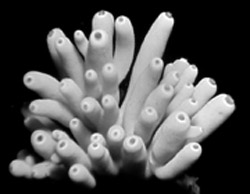Research » Marine Biodiversity » Marine Sponges » GBR Calcarea |
|
|
|
|
|
|
Research Project:
|
|
|
Australian calcareous sponges (Porifera: Calcarea): biodiversity of the Great Barrier
Reef fauna, taxonomy and systematics of Australian species
|
|
 |
This project has been funded by a research grant of the Australian Biological Resources
Study (ABRS) and the
Queensland Museum, Brisbane.
|
 |
|
|
|
Objectives of research project:
|
|
|
Recent molecular studies have shown that calcareous sponges (Porifera: Calcarea) might be more closely
related to the "higher" Metazoan phyla Ctenophora and Cnidaria than to the rest of the Porifera
(Hexactinellida/Demospongiae), yet no one has worked on this group in Australasia for over 50 years.
First results of my postdoctoral project at the Queensland Museum show that Calcarea are highly specious
in tropical Australasia, far more diverse than so far documented in the literature. The world heritage
Great Barrier Reef is largely unexplored and undocumented with respect to calcarean biodiversity. This
project will document GBR Calcarea using modern multidisciplinary geobiological approaches, producing
new insights into calcarean and poriferan phylogeny and phylogeography.
|
|
|
Calcareous sponges are known since the Cambrian, and some of them were reef-building organisms through
different periods of earth history ('Pharetronida'). Knowledge of Recent calcareous sponges worldwide
is substantially poorer than for other groups of Porifera, given their difficult taxonomy and cryptic
life style, and the state of identification for most of the Calcarea collections is still relatively
rudimentary.
|
|
|
One of the main objectives of the current research project is to work on an taxonomic inventory of the
calcareous sponge fauna of the GBR, especially focusing on the fauna of cryptic habitats. Cryptic
habitats provide a large surface area within the reef, and the diverse sponge fauna (Demosponges,
Calcarea) is one of the main constituents of the sessile macro-benthos. Numerous new taxa have been
found already within the large cryptic areas of the GBR, and these taxa will contribute significantly
to the understanding of the phylogeny, taxonomy, and paleo-ecology of the Calcarea as a whole, as well
as to the understanding of coral reef biodiversity.
|
|
|
|
|
|
|
|
Phylogeographic studies, in collaboration with the Molecular Zoology Lab of the University of Queensland
(SOLS, UQ ), of selected calcarean taxa from the GBR and SW Pacific are carried out and provide new
insights into the genetic relationships within- and between these populations, allow statements on
intra-specific variability of investigated calcarean taxa, and provide indications on how (small)
differences in (spicule) morphology correlate to genetic divergence. A detailed morphological study of
spicule geometry of analyzed taxa will accomplish the molecular studies.
|
|
|
|
Additional comparative taxonomic studies are planned on the Calcarea from the fore reef and deeper fore
reef areas. Selected samples for taxonomic investigations will be taken of the associated fauna in- and
outside of cryptic habitats to work on a better understanding of the whole community. The second focus
of the project will be the investigation of biocalcification processes of spicules and (if present) of
the rigid secondary calcareous skeleton, and, at a later stage, revise Australian Calcarea.
|
|
|
|
See Publications for results of this project.
|
|
|
|
My main research sites in the field are around Heron Island (southern GBR),
Lizard Island (northern GBR), Myrmidon Reef (central GBR), and at the
Osprey Reef (N´Queensland Plateau, Australia). (although I visit a large
variety of GBR sites on collection trips of the Queensland Museum)
|
|
|



